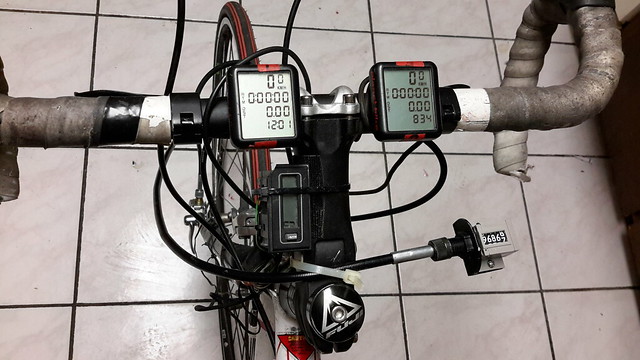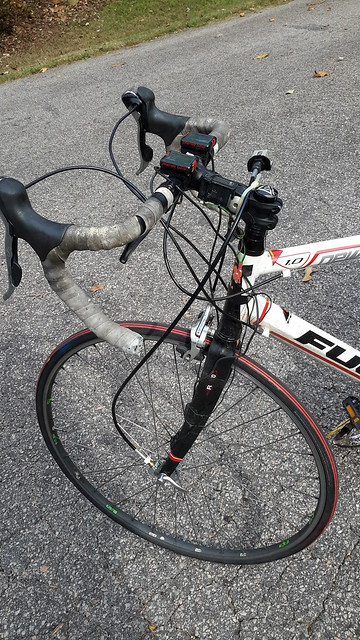 tmp_31073-20151116_230030-2021207390 by nfw4, on Flickr
tmp_31073-20151116_230030-2021207390 by nfw4, on Flickr tmp_31073-20151117_125942-1998020710 by nfw4, on Flickr
tmp_31073-20151117_125942-1998020710 by nfw4, on Flickr tmp_31073-20151119_084032-1878168260 by nfw4, on Flickr
tmp_31073-20151119_084032-1878168260 by nfw4, on FlickrI have checked the performance of Kevin's mechanical counter by operating it simultaneously with three electronic counters set up as revolution counters. Over trips totaling 25 miles, I stopped at intervals and compared the readings of the electronic counters with that derived from the mechanical counter by dividing the reading by 23.6364. Often the mechanical counter gave exactly the same reading as that of the electronic counters down to 0.01 rev and deviations were never more than 0.02 rev.
On one occasion , I measured a 5-km course for certification and found that all four meters agreed precisely at all stages of the operation. (With my 700 wheel the mechanical meter developed 18,172 cts/ml or 11,292cts/km.)
One of the electronic meters was a commercial counter and the other two were Protege 5 bicycle computers set up to count revolutions. The zero point on the wheel for one of the Proteges was set ahead by 0.2 rev, so that in the unlikely event that a spoke magnet accidentally stopped on a sensor and generated a spurious pulse, this would be detected as difference in meter readings. The lower reading or readings would then be used.
When going from forward to reverse, there is a lag of six inches before this movement is detected on the mechanical meter. However, this is of little consequence except for having to remember to take readings only after traveling forward for about a foot.
An initial attempt to mount the drive gear was thwarted because the diameter of the hole (8.2 mm) was too small for the wheel axel. My old Jones meter has a hole diameter of 10.0 mm and I assumed my axel had the same diameter. However after I drilled the drive gear hole to 10.0 mm, I found my axel had an unusual 9.0 mm diameter!
I did not like the bracket for mounting the count display to the handlebar, because it did not fit my particular handlebar too well and got in the way of my hand grip. Therefore I simply attached the cable sheath to the stem with an electrical tie. This had the advantage that it allowed the sheath to assume a smooth curve. No lubrication was necessary.
After testing for quite a long time, I disconnected the meter display and found that the cable was 4 mm too long. The metal flange on the sheath could not therefore be tightened against the black mounting body. This did not seem to affect measurements, but nonetheless I decided to correct this. It is very difficult to cut the cable, so I fashioned a spacer from the end of plastic tie (as shown in the bottom of the photograph) to fit just in front of the flange. However, this was not altogether satisfactory since the tightening nut barely engaged the threads. Kevin tells me he has a longer plastic connector for joining the cable to the drive on the meter display, and if this is used it will allow a spacer to be inserted at the display end and the metal flange to be tightened to the body.
Mechanical counters cannot compare to electronic counters in terms of easy mounting, superior display, and simplicity of operation from the use of fewer readings and calculations. Nevertheless, Kevin's modification has made the mechanical counter more efficient and less prone to erroneous readings.
